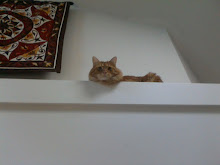 By popular request I now show the tower in the stage after the final major construction has been completed. The gray angled area of "roofing" around the lower part of the turret is actually thick card that is going to be the base of the tiling. The tiling itself will be made of strips of thin card cut to decreasing lengths (a supply of these is scattered around the worktop the tower stands on). Between the roofing and the first floor windows is the gallery fashioned from a rectangle of foam core, with corbels made of foam core off-cuts. I'm thinking of painting this in a half-timbered style. The small gray verticle rectangles on the wall of the turret are going to form the base for the four clock-faces. These will be taken from cut-out printed photos of a suitable period clock.
By popular request I now show the tower in the stage after the final major construction has been completed. The gray angled area of "roofing" around the lower part of the turret is actually thick card that is going to be the base of the tiling. The tiling itself will be made of strips of thin card cut to decreasing lengths (a supply of these is scattered around the worktop the tower stands on). Between the roofing and the first floor windows is the gallery fashioned from a rectangle of foam core, with corbels made of foam core off-cuts. I'm thinking of painting this in a half-timbered style. The small gray verticle rectangles on the wall of the turret are going to form the base for the four clock-faces. These will be taken from cut-out printed photos of a suitable period clock.*
I'm English and normally regard metric as the work of the Devil, although I concede it does have its uses in fine-scale modelling. And so I've used it here. Each strip is 7mm wide, with cuts made on one long edge every 4mm to a depth of 5mm to represent the individual tiles. The longest strip will run around the lower edge of the base area, with overlapping strips of decreasing length upwards from there, set about 5mm up from the edge of each lower run. Once these are fixed in place with contact adhesive, the whole will be painted (probably slate gray), given a black wash to pick out the "tiles" then varnished. A strip of tinfoil will be glued to the area between the tiling and the turret wall and painted to represent lead-sheet waterproofing. *
And then it's on to the door, the wall and gatehouse - and the actual paintwork for the tower.





3 comments:
Hello there A.J.,
That's very nice looking tower. I also liked your idea of using foil to approximate the lead flashing on roofs. I'll have to file that one away for future use. Of course, with a structure that already looks as fantastic as it does, even though you have not finished it yet, you know that you will know have to design and build a few other village buildings to compliment your tower and soldiers. Looking very forward to examples of your continued work!
Best Regards,
Stokes
P.S.
Yes, metric (Boo! Hissssss!) is the work of the devil. GIve me good old Imperial measurement any day. But millimeters are very useful in modeling work as you point out.
I concur with Stokes comments. It looks great already.
-- Jeff
The tower is looking good
I agree on the metric measures
-- Allan
Post a Comment